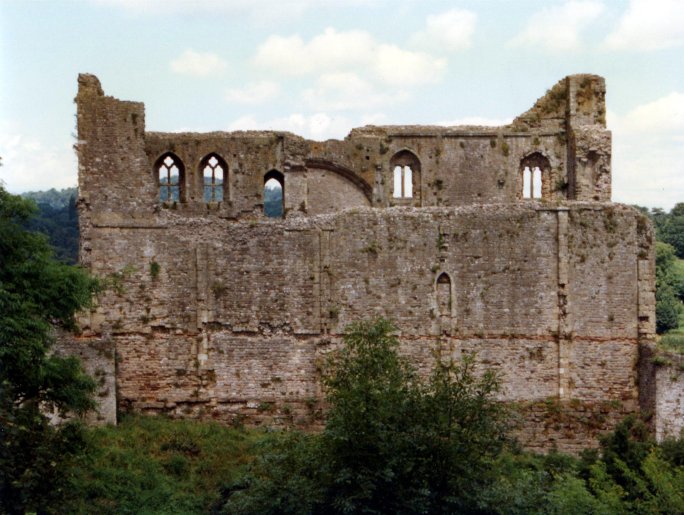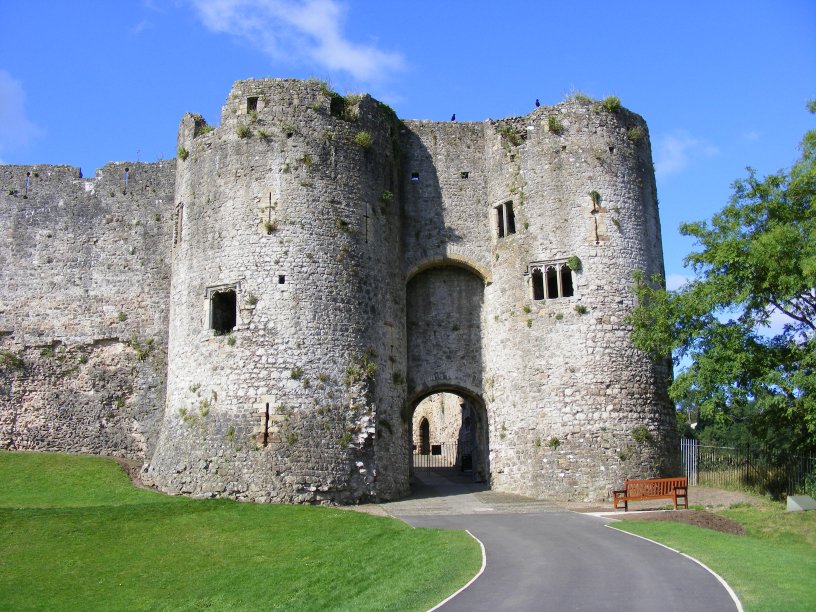Chepstow

According to the Domesday Book of 1086 Chepstow was one of the castles built by Earl William Fitz Osbern
(d.1071). What form the castle took in his lifetime is open to
debate. It is often assumed that he was responsible for
building the great hall block seen above. This rectangular hall
keep is over 100' long by 40' deep. There were
probably also contemporary curtain walls forming baileys to east and
west. The original tower was two storeys high above a half
basement, with pilaster buttresses and an entrance at first floor level
to the south. From within this a stairway, built into the thickness of the
wall, ran up to the lost battlements. Much Roman tile is used in the fabric of the structure and
this was certainly the first masonry built on the site. Another
possibility is that this hall was built by King Henry I
to meet the princes of Wales at, but this theory is unprovable. What is
certain is that the hall keep has parallels with nearby castle keeps,
such as Monmouth, Grosmont, Goodrich and possibly St Briavels.
A rarely explored possiblity is that the tower actually predates
the Norman Conquest. Obviously there is no archaeological data to
help sort out this conundrum.
King Henry I (d.1135) granted Chepstow castle to the Clare
family whose male line died out in 1176. The most famous member of
the family was Earl Richard Clare of Chepstow. He, like his father,
Gilbert, is currently and wrongly known by the anachronistic nickname, Strongbow. In 1139 Earl Gilbert had
married his sister, Rose Clare, to Baderon Monmouth (d.1170) and in some manner
obtained control of Goodrich castle.
On Earl Richard's death both castles passed through royal custody
to the great Earl William Marshall of Pembroke. He held Chepstow castle from 1189 until his death in 1219.
In 1202 he reunited the honour with Goodrich castle.
William and his sons are said to be responsible for much of the
current masonry at the castle, but, as ever with such claims, there is no
proof. Traditionally Fitz Osbern is supposed to have built the
great hall keep which still dominates the castle. Tradition also
has it that the castle then remained unaltered until 1189, when William
Marshal brought it up to date as a castle of the first rank. This
‘history' is based on the supposition that both Williams were
great men and therefore must have both built great castles.
The illogic of such a statement is obvious. Beyond the Domesday Book entry there is no evidence at all that either
man did anything at Striguil and the knowledge that William Fitz Osbern
had so little time to build the keep must throw even the interpretation
of this Domesday evidence into question. Further, why would
William Marshall spend a fortune on a rather out of the way castle,
even if it was the head of his second and least powerful earldom?
In reality we have little idea of the dates of the castle masonry,
other than nothing major was built at the castle between 1176 and 1189
when the fortress was in royal hands. Further,
dendrochronological dating shows that the castle outer gates were not
constructed until soon after 1151. This would suggest that the
bulk of the castle was completed under the Clare earls of Striguil
(1138-76), rather than the later Earl Marshalls of Pembroke
(1189-1245).
The castle boasts a twin towered gatehouse, as seen below, which once held
these mid twelfth century wooden gates - the oldest known surviving castle gates in
the country. If the gates do date back to the Clare tenure, then
it suggests the surrounding gateway did too. That said the
gatehouse as
seen today is a composite affair of many ages.
Regardless of its compositon,
twin towered gatehouses have invariably been claimed as structures of
the thirteenth century. The evidence of Chepstow and Pevensey is
now beginning to challenge this assumpton. The foundatin date of
Criccieth in the 1180s may also challenge this. Twin towered gatehouses are discussed on their own page.
At the opposite, north end of the castle, is a powerful
rectangular gatetower and barbican which is also of several building phases.
Within the rear of this gatehouse is a window similar to those
found in the keep at Goodrich castle.
Both these fortresses were held by the Clares and then the Crown
in the twelfth century. Again it is also not impossible that
these windows were salvaged and placed in new masonry works.
Within the lower ward are the late thirteenth century domestic
buildings of the Bigods and the powerful D shaped Marten Tower. The latter was the
prison of the regicide, Henry Marten.
Why not join me at Chepstow and other British castles this October? Please see the information on tours at Scholarly Sojourns.
Copyright©2010
Paul Martin Remfry


